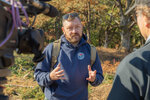















In her 300-page thesis on the history of the Confederated Tribes of the Chehalis Reservation, Mary DuPuis, a Chehalis Tribal Member with a doctorate in Indigenous development, writes some form of the word “fire” about 40 times. “Burn,” in various tenses, appears another 12.
Once, fire is referred to as a crisis. Another time, being fired from a job. Three times, it appears in descriptions about guns.
But, mostly, “fire” appears throughout the Chehalis history as a positive. For warmth, cooking or smoking food, celebration, change and agricultural benefit.
“The Chehalis prairies were managed by the tribe through controlled burning at the end of the gathering season,” DuPuis writes, citing oral history, court records and historical documents. “Planned burning of the grasses kept the land fertile and ensured optimal growth of camas and other plants.”
Those prairies included the present-day communities of Grand Mound, Tenino, the Newaukum and Napavine area, Boistfort and Fords Prairie. Places where fire is not welcome, for obvious reasons. For decades, the goal has been suppression.
With significant previously unburnt fuel, the 2018 Scatter Creek Fire took out homes and businesses, among other valuable manmade and natural resources. That’s just one of many examples where the suppression strategy backfired — literally.
For the last several years, Department of Natural Resources (DNR) and the Washington Department of Fish and Wildlife (WDFW) have been making an effort to listen to the tribe’s ancient fire knowledge. Under a new DNR-run program, the agencies are hoping responsible private landowners, county fire district employees, nonprofit land owners and timber companies can learn alongside them.
“Members of the Chehalis Tribe do our test fires and say prayers for the test fires,” said WDFW’s Scatter Creek Wildlife Area Manager Bill Kronland. “They set the stage for our burns and provide that reach back to the ancient history of the landscape.”
On a Thursday morning field trip, about a dozen people walked around the WDFW unit at West Rocky Prairie as they aim to earn a certification for controlled burning.
The program is not mandatory. Yet, in under one year, DNR’s certified burner Program Manager Kyle Lapham has had 73 students in his course. He’s graduated five after they each completed an in-person prescribed burn under Lapham’s supervision.
Certification offers burn managers higher liability protection by requiring burn plans and competency checks. Overall, Lapham said, “The whole point is to grow the amount of responsible burners in the state.”
By increasing the competency of people who burn, agencies hope to help ease the public’s “rightfully nervous” feelings about prescribed burning, Kronland said.
Prescribed burning has benefits beyond wildfire prevention, too. While WDFW doesn’t play a role in the certification program, Kronland was pleased to have the students on the Scatter Creek area’s Mima Mound-dotted prairie.
There, they had the chance to put their hands in the dirt and ash of a recently prescription-burned oak woodland. Already, new oak sprouts dot the scorched ground.
Species in the area, including endangered plants, butterflies, the Oregon spotted frog and the Mazama pocket gopher, enjoy the open area, puddles and sunshine. If evergreens grow over the prairie, these already fragile species are at higher risk of extinction.
Fire, Kronland said, can help — especially in small doses.
“It’s kind of like taking off layers of an onion,” he said. “The first burn we do, it might be kind of skunky through there. … The next time we come in, we take another layer of this. We’re getting down to the core. What we’ll do now is, here when it starts raining in a little bit, we’ll mow down the dead shrubs you see and then we will put in native seed.”